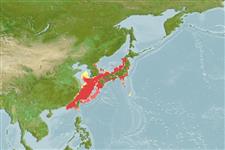Пластиножаберные (акулы и скаты) (sharks and rays) >
Rhinopristiformes (Shovelnose rays) >
Rhinobatidae (Guitarfishes)
Etymology: Rhinobatos: Greek, rhinos = nose + Greek, batis, -idos = a ray (Raja sp.) (Ref. 45335).
Eponymy: Hermann Schlegel (1804–1884) was a German-born zoologist who spent much of his life in the Netherlands. [...] (Ref. 128868), visit book page.
More on authors: Müller & Henle.
Environment: milieu / climate zone / depth range / distribution range
экология
морской демерсальный; пределы глубины ? - 200 m (Ref. 30573). Subtropical; 42°N - 21°N, 117°E - 143°E (Ref. 114953)
Northwest Pacific: Japan to Taiwan, reports from Philippines and India probably appear to be other species (Ref. 114953).
Size / Вес / Возраст
Maturity: Lm ? range ? - ? cm
Max length : 100.0 cm TL самец/пол неопределен; (Ref. 637)
Found near shore on sandy-mud bottoms (Ref. 11230, 30573). Reported to occur offshore (Ref. 58784). Feeds on small benthic animals. Ovoviviparous (Ref. 50449). Males mature at ca. 55 cm TL. Produces litters of 1-14 pups (Ref. 114953). The best edible fish in the family, served in raw slices or hard boiled with seasonings (Ref. 637). Dried fins used for shark-fin soup (Ref. 30573).
Life cycle and mating behavior
половая зрелость | размножение | нерест | икра | Fecundity | личинки
Exhibit ovoviparity (aplacental viviparity), with embryos feeding initially on yolk, then receiving additional nourishment from the mother by indirect absorption of uterine fluid enriched with mucus, fat or protein through specialised structures (Ref. 50449).
Compagno, L.J.V., 1999. Checklist of living elasmobranchs. p. 471-498. In W.C. Hamlett (ed.) Sharks, skates, and rays: the biology of elasmobranch fishes. Johns Hopkins University Press, Maryland. (Ref. 35766)
Статус Красного Списка МСОП (Ref. 130435: Version 2024-2)
Угроза для людей
Harmless
Использование человеком
рыболовство: коммерческий
дополнительная информация
инструменты
Специальные отчеты
Скачать в формате XML
ресурсы в Интернет
Estimates based on models
Preferred temperature (Ref.
123201): 14.4 - 27.1, mean 23.6 °C (based on 475 cells).
Phylogenetic diversity index (Ref.
82804): PD
50 = 0.5000 [Uniqueness, from 0.5 = low to 2.0 = high].
Bayesian length-weight: a=0.00295 (0.00151 - 0.00578), b=3.13 (2.96 - 3.30), in cm total length, based on LWR estimates for this (Sub)family-body shape (Ref.
93245).
Trophic level (Ref.
69278): 3.5 ±0.37 se; based on food items.
устойчивость к внешним воздействиям (Ref.
120179): очень низкий, минимальное время удвоения популяции более 14 лет (Fec=6).
Fishing Vulnerability (Ref.
59153): High vulnerability (60 of 100).
